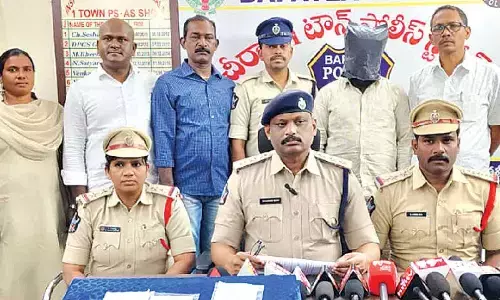A heaven on the hills

The early morning autumn air at Kalimpong was redolent with the fragrance of the surrounding greenery a refreshing and welcome change from the grey monotone so typical of the cities As we looked out from the window, we could see a dense drape of mist and fluffy white clouds We eagerly gulped in deep breaths of the sweet mountain air
The early morning autumn air at Kalimpong was redolent with the fragrance of the surrounding greenery - a refreshing and welcome change from the grey monotone so typical of the cities. As we looked out from the window, we could see a dense drape of mist and fluffy white clouds. We eagerly gulped in deep breaths of the sweet mountain air.
A little later there was a soft knock on our door and soon all our attention was seized by steaming cups of aromatic Darjeeling tea, which seemed equally inviting. Having sated our gustatory whims with scant regard to the calories, we embarked out of our hotel room to experience Kalimpong- a collage of green hills, the endless blue skies and the abundant colours of blossoms to titillate our visual senses.
The approach to Kalimpong passes through the Mahananda Wildlife Sanctuary. The ride is a pleasure with the thick canopies of the forest that fill the heart with joy. A steady uphill climb begins as soon as the forest ends. Flanked by the gorgeous, serpentine river Teesta that meanders down the hilly terrain, the path uphill is any traveller's delight.
While on one side there is the massive, expanse of green foliage, on the other side flow there are the silver gurgles of the magical river. The eyes tired with staring at neon lights and concrete walls feast on the views of the forest. There is nothing to disturb the peace here; even the low, guttural humming of the vehicle’s engine rhymes in sync with the bird chirps. The scene all around serves as a soothing reminder that nature still holds sway over the earth, in spite of the numerous nuances of development.
A vibrant and bustling hill town at the foothills of the majestic Shivalik ranges in the lower Himalayas, Kalimpong was a part of Sikkim in the 18th century. In the early 19th century the Bhutanese occupied the town and began to rule it.
Following the Treaty of Sinchuyla in 1865, it came under the sway of the British rule and subsequently became a part of India after 1947. Religion has had a major role in the development of Kalimpong. The town, which was a major centre for Scottish Missionary activity in the 1900s, has played host to a multitude of cultures that have made the place their abode, integrating into the mainstream and yet managing to retain their unique individuality.
Here, it is not uncommon to see "Dhwajas" (Tibetan Flags) floating in the mild breeze on housetops; in a similar manner, the town boasts of a fair number of temples and churches with towering spires. The town of Kalimpong despite its etymology remains drenched in serenity with its fair share of colour and buzz.
One lazy afternoon we head out towards Deola Hill, Kalimpong’s highest point. After an hour of trekking later, we are finally at the top of Deolo Hills with mist and cloud faithfully following us. Needless to say, the pair plays spoilsport and we miss out on a spectacular view of the snows of Kanchenjunga, which we have heard can be seen from here. We, however, are able to see the town centre below, sandwiched between Deola and Durpin Hills. We also get a bird's-eye view of the scattered buildings below and of the reservoir aptly termed Deolo Lake. As we stare into the huge basin that holds water for the entire town and surrounding regions around the year, I come to realise that whatever man may attempt to do, he will never be able to beat nature. Such a comforting feeling!
A little later we descend back to the town and visit the MacFarlane Memorial Church, a prominent landmark and considered amongst the famous places to see in Kalimpong. Named after William MacFarlane, the first missionary from the Church of Scotland who visited the region in 1870, the church with its tall spires and scenic setting bears a striking resemblance to the Scotland countryside.
Kalimpong is also home to some of the most beautiful nurseries in the country and now is our time to visit them. Here the mist and cloud fail to create any ruckus, on the contrary, they only add to our experience. We soon find ourselves in the colourful company of hundreds of varieties of cactus, Indo-Burmese orchids and exotic tubers, rhizomes, and what not! The nursery spread over two acres is fed by a natural spring. The entire setting feels like heaven.
No trip to Kalimpong can be complete without a trip to the Neora Valley National Park – one of the richest biological zones in northeast India. The endangered species of the Red Panda and the Black Asiatic Bear inhabits this place. We also manage to make it to the Jelepla Viewpoint, where the confluence of the rivers Teesta, Relli, and Reang can be viewed through wired fences. Jelepla Viewpoint also offers a splendid view of the snowcapped Mount Kanchenjunga (which we again miss out because of the mist) and the Jelepla Pass that was once used for trade with Tibet. If you are planning to visit a hill station in India any time soon, Kalimpong can be a good choice.
With its green meadows, undulating valleys, dense virgin forests, and the majestic Kanchenjunga as a magnificent backdrop, it is a perfect getaway. "The grass is always greener on the other side," is what you would have read as a proverb, but here at Kalimpong, I can assure you that you will be sure to spot the greenest grass.














